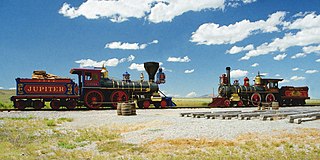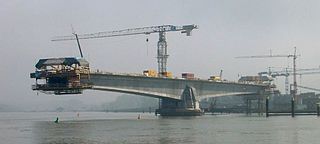Related Research Articles

A tennis court is the venue where the sport of tennis is played. It is a firm rectangular surface with a low net stretched across the centre. The same surface can be used to play both doubles and singles matches. A variety of surfaces can be used to create a tennis court, each with its own characteristics which affect the playing style of the game.

Placer mining is the mining of stream bed (alluvial) deposits for minerals. This may be done by open-pit or by various surface excavating equipment or tunneling equipment.

Golden Spike National Historical Park is a United States National Historical Park located at Promontory Summit, north of the Great Salt Lake in east-central Box Elder County, Utah, United States. The nearest city is Corinne, approximately 23 miles (37 km) east-southeast of the site.

Capitol Reef National Park is an American national park in south-central Utah. The park is approximately 60 miles (100 km) long on its north–south axis and just 6 miles (10 km) wide on average. The park was established in 1971 to preserve 241,904 acres of desert landscape and is open all year, with May through September being the highest visitation months.

A cantilever bridge is a bridge built using structures that project horizontally into space, supported on only one end. For small footbridges, the cantilevers may be simple beams; however, large cantilever bridges designed to handle road or rail traffic use trusses built from structural steel, or box girders built from prestressed concrete.

Sand casting, also known as sand molded casting, is a metal casting process characterized by using sand — known as casting sand — as the mold material. The term "sand casting" can also refer to an object produced via the sand casting process. Sand castings are produced in specialized factories called foundries. In 2003, over 60% of all metal castings were produced via sand casting.
A sandbox is a sandpit, a wide, shallow playground construction to hold sand, often made of wood or plastic.

Centring, centre, centering, or center is a type of falsework: the temporary structure upon which the stones of an arch or vault are laid during construction. Until the keystone is inserted an arch has no strength and needs the centring to keep the voussoirs in their correct relative positions. A simple centring without a truss is called a common centring. A cross piece connecting centring frames is called a lag or bolst.

Mathey College is one of seven residential colleges at Princeton University. Located in the Northwest corner of the Princeton Campus, its dormitories and other buildings are predominantly in the Collegiate Gothic style. Since the fall of 2007, Mathey has been a four-year residential college, paired with Rockefeller College.

Nittany Valley is an eroded anticlinal valley located in Centre County, Pennsylvania. It is separated from the Bald Eagle Valley by Bald Eagle Mountain and from Penns Valley by Mount Nittany. The valley is closed to the north by a high plateau that joins these two mountain ridges, but is open to the south at the southern terminus of Mount Nittany. The valley drains to Bald Eagle Creek through water gaps in Bald Eagle Mountain formed by Spring Creek and Fishing Creek, along with smaller streams running through Curtain Gap and Howard Gap. The northwest side of the valley between the Bald Eagle Mountain ridge and the lower Sand Ridge is also known as the Little Nittany Valley.

The Hillsboro Main Street Bridge is a concrete tied arch bridge located in Hillsboro, Oregon. The bridge carries light rail traffic on the MAX Blue Line over Main Street and 18th Street. Completed in 1997, the 425-foot-long (130 m) bridge was built with a 78-foot-tall (24 m) arch in the center. It is located between the 12th Avenue Station and the Fair Complex Station.
There are different types of theatres, but they all have three major parts in common. Theatres are divided into two main sections, the house and the stage; there is also a backstage area in many theatres. The house is the seating area for guests watching a performance and the stage is where the actual performance is given. The backstage area is usually restricted to people who are producing or in the performance.

Arches National Park is a national park in eastern Utah, United States. The park is adjacent to the Colorado River, 4 mi (6 km) north of Moab, Utah. The park contains more than 2,000 natural sandstone arches, including the well-known Delicate Arch, which constitute the highest density of natural arches in the world. It also contains a variety of other unique geological resources and formations. The national park lies above an underground evaporite layer or salt bed, which is the main cause of the formation of the arches, spires, balanced rocks, sandstone fins, and eroded monoliths in the area.

In civil engineering, a cut or cutting is where soil or rock from a relative rise along a route is removed. The term is also used in river management to speed a waterway's flow by short-cutting a meander.
A core is a device used in casting and moulding processes to produce internal cavities and reentrant angles. The core is normally a disposable item that is destroyed to get it out of the piece. They are most commonly used in sand casting, but are also used in die casting and injection moulding.

The Union Meetinghouse is a historic church on United States Route 7 in Ferrisburg, Vermont. Built in 1840, it is architecturally an eclectic combination of Federal period design with Gothic Revival features. It was listed on the National Register of Historic Places in 1978.
Sand-e Nur Mohammad is a village in Bahu Kalat Rural District, Dashtiari District, Chabahar County, Sistan and Baluchestan Province, Iran. At the 2006 census, its population was 637, in 103 families.
Sand-e Hamzeh is a village in Sand-e Mir Suiyan Rural District, Dashtiari District, Chabahar County, Sistan and Baluchestan Province, Iran. At the 2006 census, its population was 534, in 88 families.
Sand-e Mir Suiyan is a village in, and the capital of, Sand-e Mir Suiyan Rural District of the Central District of Dashtiari County, Sistan and Baluchestan province, Iran.

Victoria Park Post Office is a heritage-listed post office at 414 Albany Highway, Victoria Park, Western Australia, Australia. It was added to the Australian Commonwealth Heritage List on 22 August 2012.
References
- ↑ Ashok Kumar Jain, B.C. Punmia, Building Construction, Firewall Media, 2005, p. 435.